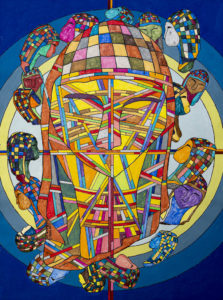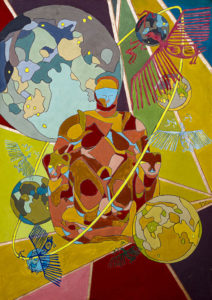THE DAWN OF MANKIND SERIES
ET Dieu créa… la femme
The oldest Homo Sapiens remains, found in Ethiopia’s Omo River Valley, date back around 200,000 years, although recent discoveries have identified much older archaic versions of Homo Sapiens in Morocco.
Anatomically similar to us, these human beings produced a variety of utilitarian tools. However, this was nothing new since their predecessors (i.e. other much older Homo species ranging from African Homo Habilis and Homo Ergaster, to Eurasia, the ‘Homo Erectus, Neanderthal and other species) were also able to produce the tools they needed to meet their basic survival needs.
From about 100,000 years ago, groups of hunter-gatherers of Homo Sapiens, taking advantage of different periods of climate change, began their migration out of Africa and went to populate the rest of the world. But it wasn’t until about 70,000 years ago, with the advent of what Yuval Noah Harari called “the cognitive revolution,” that our ancestors, perhaps through genetic mutation, developed the salient characteristics that make us fully modern humans: the birth of a thought, supported by an adequate language, allowing humans to collaborate in large numbers, and to develop new behaviors such as spirituality and the first forms of religiosity, the habit of burying loved ones, and early art forms. And parallel to the rock art, essentially representing animals and hunting scenes, our distant ancestors began to produce, all over the world, small stone statuettes representing steatopygous women. The exact cultural significance of these statuettes is unclear. Check the paint descriptions for more information.
Click on each painting to expand
Matriarchy (2021)
Watercolor pencils and ink on paper, 42×30 cm
The painting is inspired by the work of Marija Gimbutas, Lithuanian archaeologist and linguist who studied the Neolithic and Bronze Age cultures of Ancient Europe, an expression she introduced. Among other, she is the author of The Goddesses and Gods of Old Europe, The Language of the Goddess and The Civilization of the Goddess. On the basis of in-depth studies of Paleolithic and Neolithic art (including the analysis of over twelve thousand statuettes of female figures), Marija Gimbutas hypothesized the existence of a prehistoric matriarchal and gyno-centric world, which lasted for the entire Paleolithic,up to about the middle of the Neolithic (six thousand years ago). At that moment, matriarchal societies were impacted by the arrival of the patriarchal culture brought by the Indo-Europeans in the Bronze Age. According to Marija Gimbutas, these two systems would have merged to generate the classical societies of historical Europe.
As a matter of fact, after the cognitive revolution, which some seventy thousand years ago gave birth to spirituality, symbolism and art, our distant ancestors, living in small groups of nomadic hunter gatherers, produced, all across the world, from the Iberian Peninsula to Siberia, small statuettes in stone (steatite, calcite, limestone and other) representing steatopygic women. In the nineteenth century, when they were discovered, they were named Venus figurines in reference to the Roman goddess of beauty Venus; however, since then, considerable diversity in opinion has arisen as to the function and significance of the figures. The exact cultural meaning of these figures may never be known. Archaeologists speculate, however, that they may be symbolic of security and success, fertility, or mother goddesses.
The artwork represents the statuette of the Venus of Polichinelle. a small statuette (6 cm long) which was originally carved in green steatite. Six matriarchs are gathered at the center of a gigantic vulva, represented as the Moon: they exercise the Right of the Mother in the prehistoric society of these African nomads who reached Europe.
The Venus of Polichinelle is in fact one of the 15 figurines of steatopygic women found at the Balzi Rossi site, Grimaldi di Ventimiglia, in Italy, right at the border with France, along with the remains of 14 negroid individuals (men, women and children) of the Upper Paleolithic (about 25,000 years ago).
These are the ‘Grimaldi men’ mentioned by Senegalese historian and anthropologist Cheikh Anta Diop in ‘Nations Nègres et Cultures’. Indeed, all our distant Homo Sapiens ancestors belong to an original handful of no more than 25,000 East Africans. In times much colder than ours, during the last glaciation, which ended about 20,000 years ago, a part of these ancient Africans crossed the natural borders of the continent, and came to populate Eurasia.
PRICE: 2000 CHF (framed, covered with glass)
This painting was used for the cover of Foolish Magazine International issue #6
Das Mutterrecht (2021)
Watercolor pencils and oil on paper, 42×30 cm
The Right of the Mother, inspired by the homonymous work ‘The matriarchy. Research on gynecocracy in the ancient world in its religious and legal aspects’ Also known under the original title Maternal Law, it is the major work of the Swiss historian and anthropologist Johann Jakob Bachofen.
Published in several volumes starting from 1861, it is the first in-depth study on the theory of matriarchy (although Bachofen never used the term “Mutterrecht” in his writings, preferring instead that of “Frauenherrschaft”, or “the power of women”) through the reconstruction of an era of human history in which the figure of the mother prevailed in the feeling of existence, tracing the testimonies scattered among myths, symbols, historians’ tales and laws.
This work belongs to an ongoing cycle inspired by the so-called Paleolithic Venuses, stone figurines representing steatopygic women, female figurines found in the Aurignacian levels of numerous European locations (Brassempouy, Lespugne, Willendorf, Malta, Savignano, Balzi Rossi), characterized by adipose accumulations in the areas of the buttocks and thighs, performed with singular realism, where the other anatomical features and features of the face are neglected. According to some, they represent the feminine form existing in those times; according to others they would have a magical and religious value, linked to the cult of fertility: hence the exaggeration of the organs and parts of the body connected with this function.
In this case the work portrays a group of ‘Ladies of Brassempouy’ floating in another weightless dimension. The Lady of Brassempouy (in French ‘La dame à la capuche’, literally “The lady with the hood”) is a fragment of an ivory statuette dating from the Upper Paleolithic discovered near Brassempouy, France in 1894. With an estimated age of 25,000 years old, it is the oldest realistic representation of a human face ever found. She is represented here at the apex of her matriarchal power.
PRICE: 2.000 CHF (framed, covered with glass)
The seated Lady of the leopards (2021)
Ink and oil on paper, 42×30 cm
The painting is inspired by the Seated Woman of Çatalhöyük, a baked-clay, nude female sculpture shaped by an unknown neolithic artist in around 6000 BC. It is thought to depict a corpulent Mother goddess in the process of giving birth while seated on her throne, which has two hand rests in the form of feline heads in a Mistress of Animals motif. The statuette was unearthed in 1961 at Çatalhöyük, in Turkey. Çatalhöyük was a very large Neolithic proto-city settlement in southern Anatolia, which existed from approximately 7500 BC to 6400 BC, and flourished around 7000 BC. In the same site, archeologists uncovered, among other, wall paintings of the vultures and headless figures represented in the painting. As a part of ritual life, the people of Çatalhöyük buried their dead within the village. Before burial, bodies were often exposed in the open air for some time before the bones were buried. In some cases, graves were disturbed, and the individual’s head removed from the skeleton, to be used in rituals.
PRICE: 2.000 CHF(framed, covered with glass)
L’amore impossibile (2021)
Ink, oil and watercolor pencils on paper 42×30 cm
The painting is inspired by the Lovers of Valdaro, a pair of human skeletons dated to about 6,000 years ago discovered in a Neolithic tomb in San Giorgio, near Mantua, Italy, in 2007. The two skeletons seem to be those of individuals who died together or are buried in front of each other with their arms embraced, reminiscent of a lovers’ embrace. The couple consists of a man and a woman under the age of 20 and about 157 cm tall. The male skeleton was found with a flint arrowhead near the neck. The woman, meanwhile, had a long flint blade along her thigh and two flint knives under her pelvis. An osteological examination brought no evidence of violent death, no fractures and no microtrauma, so the most likely explanation for the presence of the flint weapons is that they were buried with them in the tomb.
PRICE: 2.000 CHF (framed, covered with glass)



